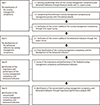Abstract
Purpose
The aim of this study was to classify nursing management competencies and develop behavioral indicators for nurse managers in hospitals. Also, levels of importance and performance based on developed criteria were to be identified and compared.
Methods
Using expert survey we classified nursing management competencies and behavioral indicators with data from 34 nurse managers and professors. Subsequently, data from a survey of 216 nurse managers in 7 cities was used to analyze the importance-performance comparison of the classified nursing management competencies and behavioral indicators.
Results
Forty-two nursing management competencies were identified together with 181 behavioral indicators. The mean score for importance of nursing management competency was higher than the mean score for performance. According to the importance-performance analysis, 5 of the 42 nursing management competencies require further development: vision-building, analysis, change management, human resource development, and self-management competency.
Figures and Tables
Figure 1
The process of the classification of the nursing management competency and the development of the behavioral indicators for nurse managers at hospital.

Notes
References
1. Lee HM, Kim JI. Core competency and manpower: A model development of intellectual core competency and competency evaluation. Seoul: Korea Management Association;2003.
2. Lim JY, Noh W, Oh SE, Kim OG. Financial ratio analysis for developing nursing management strategies in university hospitals. J Korean Acad Nurs Adm. 2013; 19(1):7–16. DOI: 10.11111/jkana.2013.19.1.7.
3. Hall LM, Waddell J, Donner G, Wheeler MM. Outcomes of a career planning and development program for registered nurses. Nurs Econ. 2004; 22(5):231–238.
4. Tørstad S, Bjørk IT. Nurse leaders’ views on clinical ladders as a strategy in professional development. J Nurs Manag. 2007; 15(8):817–824. DOI: 10.1111/j.1365-2934.2007.00769.x.
5. Byeon HS, Jnag KS. A study on the nursing managerial competency of head nurses in the general hospitals. Chonnam J Nurs Sci. 2000; 5(1):135–150.
6. Sung YH, Jeong JH. Defining the core competencies of the nurses in a tertiary hospital and comparing different units based on their respective characteristics. J Korean Acad Nurs Adm. 2006; 12(1):76–93.
7. Kim IS, Jang KS, Lee MH, Ha NS, Hong YM, Lee T, et al. Nursing management. 3rd ed. Seoul: Hyunmoon;2009.
8. Spencer LM, Spencer SM. Competence at work: Models for superior performance. New York, NY: Wiley;1993.
9. Lee HM. Competency modeling & competency evaluation. Seoul: Read & Lead;2009.
10. Schneider HL. Evaluation of nursing competence. New York, NY: Little, Brown;1979.
11. Drenkard K, Cohen E. Clinical nurse leader: Moving toward the future. J Nurs Adm. 2004; 34(6):257–260. DOI: 10.1097/00005110-200406000-00001.
12. Scoble KB, Russell G. Vision 2020, part I: Profile of the future nurse leader. J Nurs Adm. 2003; 33(6):324–330. DOI: 10.1097/00005110-200306000-00005.
13. Sullivan J, Bretschneider J, McCausland MP. Designing a leadership development program for nurse managers: An evidence-driven approach. J Nurs Adm. 2003; 33(10):544–549. DOI: 10.1097/00005110-200310000-00010.
14. Mathena KA. Nursing manager leadership skills. J Nurs Adm. 2002; 32(3):136–142. DOI: 10.1097/00005110-200203000-00006.
15. Kim HS. Analysis of the factors, the differential of performance and the awareness of significance in the competency cluster of the middle manager in general hospital [master's thesis]. Seoul: Yonsei University;2011. 1–106.
16. Kim YS, Eo YS, Lee NY. Effects of head nurses’ managerial competencies and professional nurse autonomy in nursing performance. J Korean Acad Nurs Adm. 2014; 20(4):437–445. DOI: 10.11111/jkana.2014.20.4.437.
17. Duffield C. The competencies expected of first-line nursing managersan Australian context. J Adv Nurs. 1989; 14(12):997–997. DOI: 10.1111/j.1365-2648.1989.tb01509.x.
18. Dubnicki C, Sloan S. Excellence in nursing management: Competency-based selection and development. J Nurs Adm. 1991; 21(6):40–45.
19. Chase LK. Nurse manager competencies. J Nurs Adm. 1994; 24:4 Suppl. 56–64.
20. Chase LK. Nurse manager competencies [dissertation]. Iowa City, IA: The University of Iowa;2010. 1–168.
21. Lee SM. An analysis of nursing managerial competencies: Military hospital head nurses. J Korean Acad Nurs Adm. 1997; 3(1):37–50.
22. Kim JS. Development of competency and behavioral indicator of an administrator in long-term care facility. J Korean Acad Nurs Adm. 2008; 14(4):477–487.
23. Kim SH. A study on competency of first-line nursing manager in hospital setting [master's thesis]. Seoul: Ewha Womans University;2000. 1–75.
24. Gillies DA. Nursing management: A systems approach. 3rd ed. Philadelphia, PA: Saunders;1994.
25. Lynn MR. Determination and quantification of content validity. Nurs Res. 1986; 35(6):382–385. DOI: 10.1097/00006199-198611000-00017.
26. Martilla JA, James JC. Importance-performance analysis. J Mark. 1977; 41(1):77–79. DOI: 10.2307/1250495.
27. Korea Institute for Healthcare Accreditation. KOIHA evaluation criteria for healthcare accreditation: Tertiary general hospital (Ver 2.0). Seoul: Ministry of Health & Welfare, Korea Institute for
Healthcare Accreditation;2014.
28. Cherry B, Jacob SR. Contemporary nursing: Issues, trends, & management. 6th ed. Philadelphia, PA: Mosby;2014.
29. Linton MJ, Prasun MA. Evidence-based practice: Collaboration between education and nursing management. J Nurs Manag. 2013; 21(1):5–16. DOI: 10.1111/j.1365-2834.2012.01440.x.
30. Gantz NR, Sherman R, Jasper M, Choo CG, Herrin-Griffith D, Harris K. Global nurse leader perspectives on health systems and workforce challenges. J Nurs Manag. 2012; 20(4):433–443. DOI: 10.1111/j.1365-2834.2012.01393.x.




 PDF
PDF ePub
ePub Citation
Citation Print
Print





 XML Download
XML Download